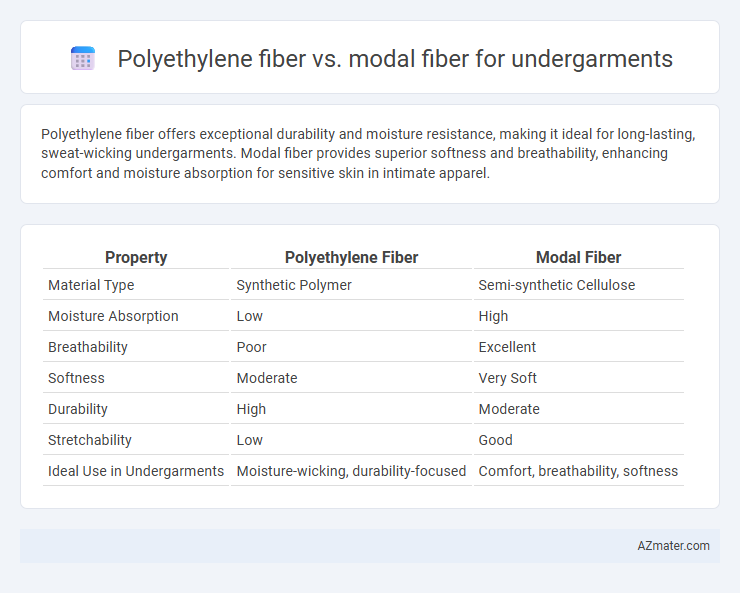Polyethylene fiber offers exceptional durability and moisture resistance, making it ideal for long-lasting, sweat-wicking undergarments. Modal fiber provides superior softness and breathability, enhancing comfort and moisture absorption for sensitive skin in intimate apparel.
Table of Comparison
| Property | Polyethylene Fiber | Modal Fiber |
|---|---|---|
| Material Type | Synthetic Polymer | Semi-synthetic Cellulose |
| Moisture Absorption | Low | High |
| Breathability | Poor | Excellent |
| Softness | Moderate | Very Soft |
| Durability | High | Moderate |
| Stretchability | Low | Good |
| Ideal Use in Undergarments | Moisture-wicking, durability-focused | Comfort, breathability, softness |
Introduction to Polyethylene and Modal Fibers
Polyethylene fiber, known for its lightweight and high tensile strength, offers exceptional durability and moisture-wicking properties ideal for undergarments requiring longevity and comfort. Modal fiber, derived from beech tree cellulose, provides superior softness, breathability, and excellent color retention, making it a preferred choice for luxury and sensitive-skin undergarments. Both fibers contribute unique performance attributes, with polyethylene excelling in durability and Modal emphasizing comfort and eco-friendly appeal.
Fiber Composition and Structure Comparison
Polyethylene fibers feature a simple, linear polymer structure composed mainly of long chains of ethylene monomers, resulting in high tensile strength, low moisture absorption, and excellent chemical resistance, ideal for durable undergarments. Modal fibers, derived from regenerated cellulose from beech trees, possess a semi-synthetic composition with a smooth, round cross-section that enhances breathability and moisture-wicking properties, promoting comfort and softness in undergarment applications. The molecular structure of polyethylene provides rigidity and durability, whereas modal's cellulose-based fibers offer superior flexibility and a silky feel, making modal preferred for softness and moisture management.
Moisture Wicking and Breathability
Polyethylene fiber offers excellent moisture-wicking properties due to its hydrophobic nature, efficiently pulling sweat away from the skin and drying quickly, making it suitable for activewear undergarments. Modal fiber, a semi-synthetic cellulose fiber, provides superior breathability and softness, enhancing comfort by allowing better air circulation and moisture absorption. Undergarments made from Modal fiber tend to feel cooler and more breathable in everyday wear, while Polyethylene fiber is preferred in high-performance scenarios requiring rapid sweat management.
Comfort and Skin Sensitivity
Polyethylene fiber offers durability and moisture-wicking properties but lacks the softness needed for undergarment comfort, often causing irritation on sensitive skin. Modal fiber excels in breathability and silky softness, making it ideal for sensitive skin by reducing friction and promoting comfort during extended wear. Its natural cellulose base enhances moisture absorption, preventing skin irritation better than synthetic polyethylene fibers.
Durability and Wear Resistance
Polyethylene fiber exhibits superior durability and wear resistance compared to Modal fiber in undergarments, maintaining structural integrity through frequent washing and abrasion. Modal fiber, while softer and more breathable, tends to degrade faster under stress, showing signs of pilling and fiber thinning. The high tensile strength and hydrophobic nature of Polyethylene fibers contribute to longer-lasting quality and shape retention in undergarments.
Stretch and Fit Factors
Polyethylene fiber offers exceptional stretchability and shape retention, making it ideal for undergarments that require flexibility and a snug fit. Modal fiber, derived from beech trees, provides a softer texture with moderate stretch but excels in breathability and moisture absorption, which enhances comfort during prolonged wear. For undergarments prioritizing stretch and fit, polyethylene fibers deliver superior elasticity, while modal fibers contribute to a comfortable, form-fitting experience with added softness.
Thermal Regulation Properties
Polyethylene fiber exhibits superior thermal regulation in undergarments due to its excellent moisture-wicking and quick-drying properties, keeping the skin dry and cool during physical activity. Modal fiber, derived from beech trees, offers softness and breathability but tends to retain moisture longer, which can reduce its effectiveness in maintaining optimal body temperature. For undergarments prioritizing efficient heat dissipation and moisture management, polyethylene fiber outperforms modal fiber in thermal regulation performance.
Environmental Impact and Sustainability
Polyethylene fiber for undergarments offers exceptional durability and moisture resistance but is derived from non-renewable petroleum sources, contributing to higher carbon emissions and limited biodegradability. Modal fiber, produced from sustainably sourced beechwood pulp, is biodegradable, uses less water and energy in production, and supports eco-friendly silk-like softness and breathability. Choosing modal fiber significantly reduces environmental impact due to its renewable raw materials and lower ecological footprint compared to petroleum-based polyethylene fibers.
Care, Washing, and Maintenance
Polyethylene fiber in undergarments offers exceptional durability and water resistance, making it easy to care for with simple machine washing and quick drying without losing shape. Modal fiber provides superior moisture-wicking and softness but requires gentle washing in cold water and air drying to maintain its fabric integrity and prevent shrinkage. Both fibers benefit from avoiding bleach and high heat to extend garment lifespan and preserve comfort.
Conclusion: Optimal Choice for Undergarments
Modal fiber offers superior moisture-wicking and breathability compared to polyethylene fiber, making it ideal for undergarments that require comfort and temperature regulation. Polyethylene fiber, while lightweight and durable, lacks the soft texture and moisture management properties essential for prolonged skin contact. Modal's sustainable sourcing and enhanced softness position it as the optimal choice for high-performance, comfortable undergarments.

Infographic: Polyethylene fiber vs Modal fiber for Undergarment
 azmater.com
azmater.com